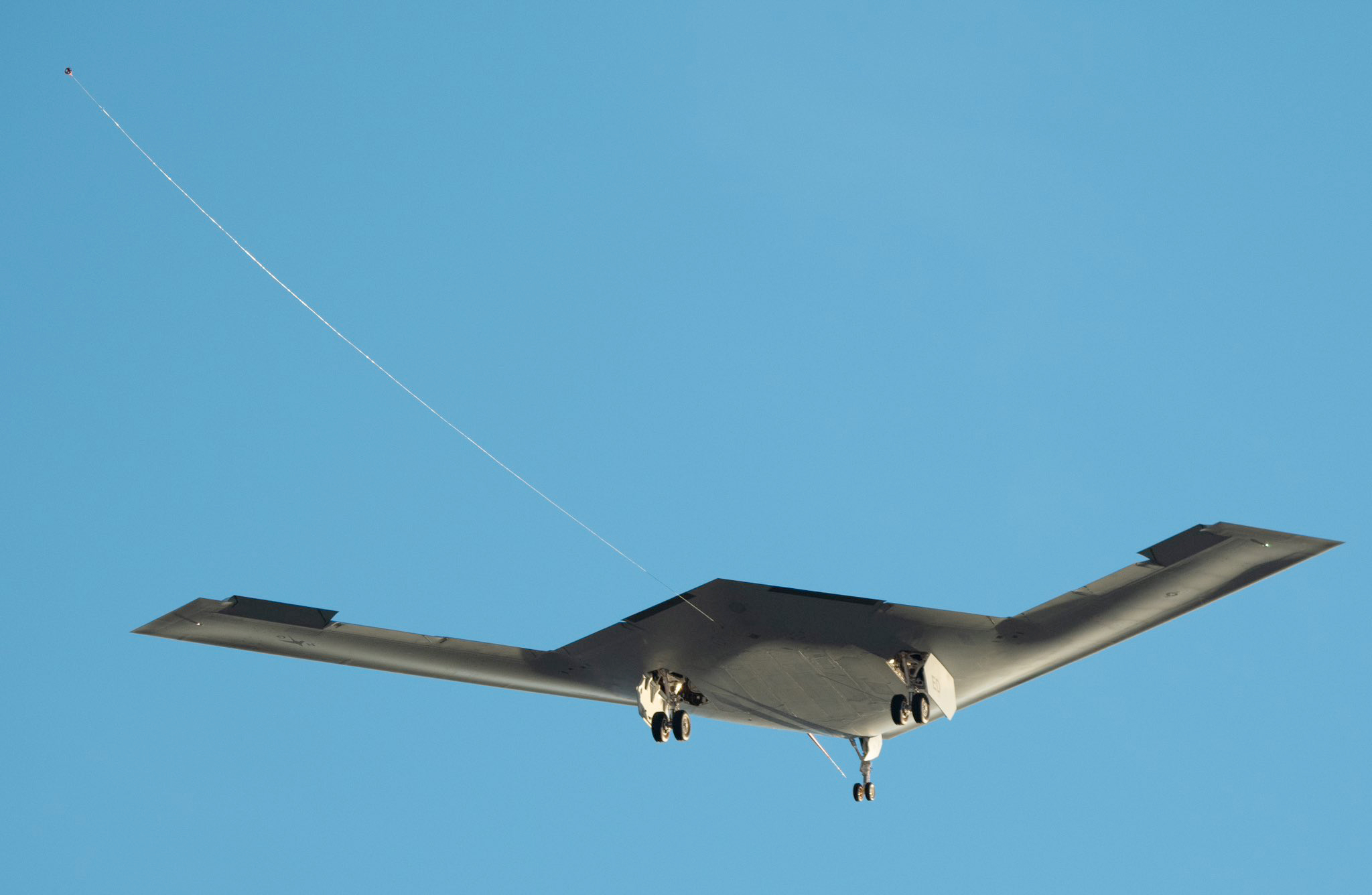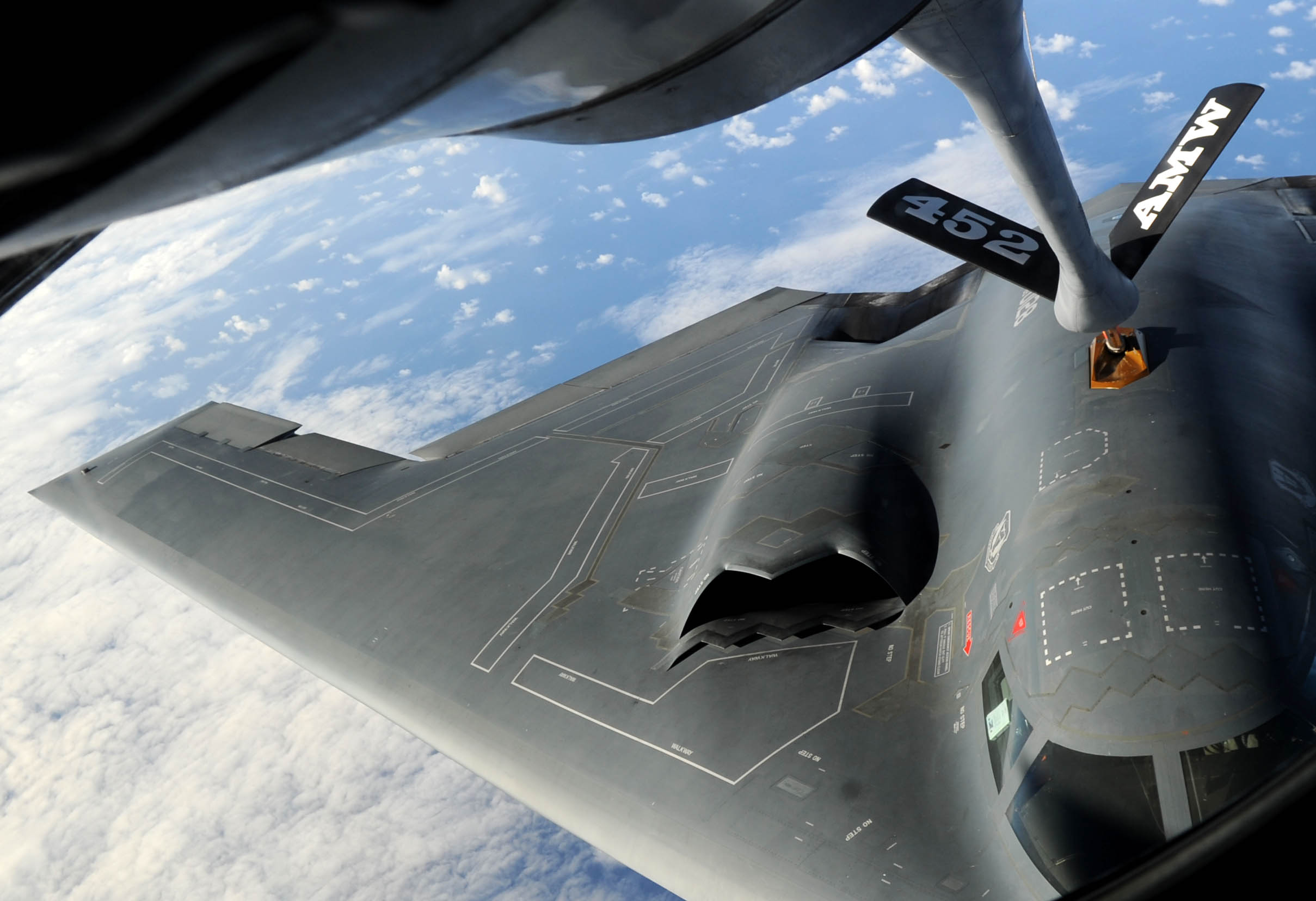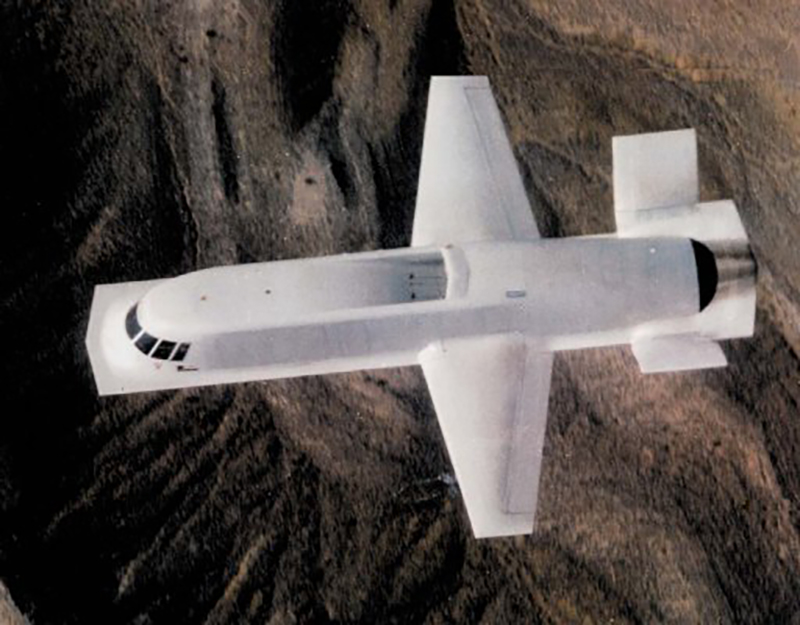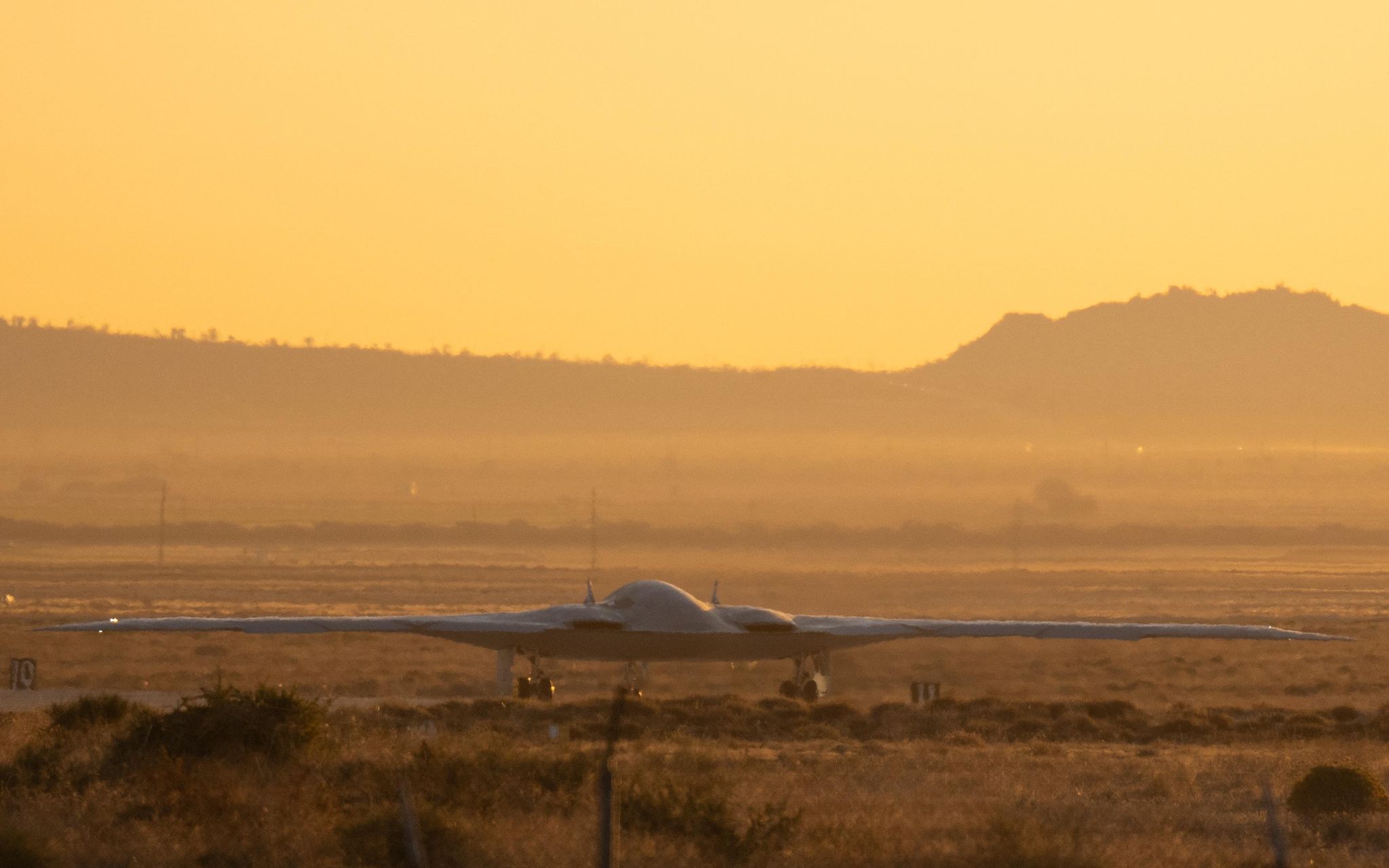The B-21’s first flight — a massive milestone for Northrop Grumman and the USAF — provides us with totally new looks at the world’s most advanced flying machine. Here are some key takeaways from what is really the Raider’s first full unveiling.
Check out our morning coverage of the B-21’s first flight here. You can read our past analysis on the B-21 and its mission set, which mirrors what we are seeing today with our own eyes, here and here.
First off, the name. Yes, It’s the B-21 Raider, but the first example of the type has a special nickname that is adorned on its gear door: Cerberus.
Cerberus is the hound of Hades that guards the gates of the underworld to prevent the dead from escaping. So, in Greek Mythology terms, the first of the B-21s has a very dark and ominous name. It is fitting for what is arguably among the most destructive flying machines ever created.
Many are asking about the long wire and aerial the B-21 was towing behind it on takeoff. Its presence should not come as a surprise as it is a normal fixture for initial flight testing. It is an air data ‘trailing cone’ used to capture ‘clean’ static air measurements that are undisturbed by the aircraft. This sensor is in addition to the jet’s long flight test air data probe installed on its lower front left side. These are critical instruments for gathering precise data for the B-21’s initial flight testing activities, in addition to the myriad standard sensors that are installed conformally around the aircraft and specialized test equipment situated inside.

Moving on to the big takeaways regarding the jet’s structure and features. Chief among them is the B-21’s planform. It is exactly what we thought it would be and it’s also what a higher-flying earlier iteration of the B-2 was supposed to be. You can read all about the B-21 design’s direct link to the Advanced Technology Bomber program’s Senior Ice design, which became the B-2 Spirit, in our feature from six years ago bringing it to light.
While pictures of the B-21 taxiing, including its empennage, have been circulating for weeks, we can now say conclusively that the B-21’s strange ‘horns’ on either side of the center fuselage barrel (or hump in this case) are indeed auxiliary air intake doors. There was speculation that they were posts for additional air data sensors, or even radar reflectors, but that is not the case.


The B-21’s conformal inlets are among the program’s most exotic (known) features that are documented publicly to have been a major challenge to realize during development. Low observable inlets are among a stealthy aircraft’s most critical attributes. Separating turbulent boundary layer air and just getting enough air at all through serpentine ducts used to hide the highly reflective engine fan faces to not starve the aircraft’s engines are major hurdles. In addition, what may not be a problem while cruising can become a huge issue at high power settings and increased angles of attack seen during terminal operations.

The B-2 has much more predominant intakes with serrated splitters along their lower edges compared to the B-21. Still, they feed serpentine ducts with the engines buried deep in the B-2’s inner wings. Getting enough air during takeoff and landing is accomplished via ‘butterfly’ or scoop-like auxiliary inlet doors that open atop the mid portion of the blended intakes/nacelles.


The B-21 accomplishes this same thing via relatively large plank-like triangular doors that open vertically back from the intake openings, similar to where the B-2’s doors are. This provides additional direct air to the Raider’s still unknown (in quantity and model) engines. This gives the jet a unique ‘horned’ or devilish appearance when on the ground taxiing, as well as while taking off and landing.
The B-21’s profile is also more striking than we pictured, with its angled side windows giving it a sinister ‘angry’ look. Its smaller stature than its bigger progenitor, the B-2, is also apparent from this angle. Its massive shelf-like ‘duckbill’ leading edge/nose is very visible, a major low-observable attribute that limits line-of-sight to the B-2’s upper fuselage from lower viewing angles, among other advantages. Considering it will likely be flying higher than most other aircraft, and ground defenses are perhaps its most important threat to evade, it is a key attribute. It’s also one that has a long history with low-observable aircraft design dating far back, with it being especially prominent on Northrop’s Tacit Blue demonstrator, the grandfather of the B-21 Raider.

We also see the black areas between the B-21’s blended engine nacelles and the center fuselage hump towards the rear portion of the jet. It remains unclear exactly why this area is that tone, although it could have something to do with the engines being mounted near there.
Overall, the B-21’s profile is remarkably sleek and its inlet and engine ‘humps’ are far less prominent than the B-2’s when viewed from the side.
The B-21’s belly is perhaps the most intriguing part of the aircraft we saw in today’s first flight. We now clearly see its primary weapons bay (more on the primary part in a moment). It is much smaller than that of the B-2, but we knew that would be the case, with the aircraft likely having less than half the B-2’s weapons payload capacity. Instead of being able to carry two Massive Ordnance Penetrators (MOPs), one will likely be contained in a B-21. It is possible that the bay is even too small for the MOP, with a new, smaller deep-penetrating weapon taking its place, but that seems less likely at this time.

The bay will likely be ‘smarter’ and more easily reconfigurable for different weapons arrangements than its predecessor too, leveraging the aircraft’s open architecture systems for easier integration of new weapons, decoys, and air-launched drones.

One major question that remains is does the B-21 have smaller secondary weapons bays, as well? This is something I have posited could (or at least should) exist to take advantage of the jet’s expanded roles and new weapons available to it. These include advanced air-to-air missiles for self-defense and the Stand-In Attack Weapon (SiAW) for fighting its way into highly protected locales and defending itself in general.
Using up space on a large primary rotary launcher for these weapons seems somewhat problematic, so having smaller and shallower auxiliary bays to accommodate them would be beneficial. It looks like this may be the case, with definite hatches of some sort next to the primary weapons bay, but it is unclear if these are there for maintenance access, including engine access, or if they are for weapons storage. The B-2 has similar panels, as well, so it is hard to tell, but the inner panels next to the primary bay are intriguing.
Adding to the possibility of additional weapons bays flanking the primary one is the fact that the B-21’s gear, while using a single truck instead of two like on the B-2, seems to stow similarly, hinging forward under a single large door that closes inward.
Finally, we have the rear. A stealthy aircraft’s exhausts are very critical to the type’s low observable capabilities, both on the radiofrequency (RF) and infrared (IR) spectrums. In this case, they look quite similar to the B-2’s exhausts, although they look even more conformal, with the engines very deeply buried, and smaller than their predecessors. They also do not have a chevron trailing edge to their planar heat diffusers. Once again, this raises the question of if the B-21 is a twin or quad-engined aircraft. We just don’t know, but if it does leverage four engines, they would need to be relatively small in size based on what we are seeing. The B-2 can fly with two engines out on the same side, just as a side note, so the B-21 should be able to with an engine out, as well, if it is indeed a twin-engine aircraft.
The B-21 appears to have a prominent shelf-like extension from its fuselage ‘hump’ at its trailing edge apex and lacks the variable geometry ‘beaver tail’ of its predecessor. This makes sense considering its similarity to the B-2’s original design, which lacked the low-altitude penetrating requirements that ended up giving birth to the aircraft’s serrated trailing edge and ‘gust-alleviating’ beaver tail.


Then there is the color, which has not changed. It remains a light gray, which would indicate that the aircraft is intended for day and night operations. This could always change, but it makes sense and is something we thought could be the case prior to the roll-out.
Size-wise we estimated the B-21 to be between 135-155 feet wide, compared to the B-2’s 172 feet. It will likely be shorter as well and the B-2 is already a transformer when it comes to viewing it head-on compared to side-on, which turns the aircraft into something akin to the size of an F-15.
The video below of the B-21 followed by its chase F-16 shows just how small it looks side on:
Finally, we have all the apertures around the aircraft. Not a lot is new there from our last look and analysis of the jet. What’s missing are the big dual radar arrays seen on the B-2. It’s very possible the B-21 will not rely on such large arrays, with advances in AESA technologies and the possible need to use semi-mature off-the-shelf systems resulting in smaller arrays. On the other hand, conformal load-bearing antenna structures (CLASs) could conceal large arrays that are built right into the B-21’s structure. Smaller common AESAs placed around the aircraft for near 360-degree sensing, communications, and electronic warfare are also quite probable. You can read all about these possibilities and about advances in radar technologies in this previous report of ours.

It’s also worth noting that the B-21 was built around a family of systems, with some capabilities being handled by other aircraft and sent through secure networks to the B-21. This could very well (and probably does) include a stealthy radar-toting asset like the so-called RQ-180. In other words, it may have offset even some features found on the B-2 to other platforms. And of course, this is a prototype — a very production representative one though. Certain systems and avionics could (and likely will) be added later and/or featured in follow on aircraft now under construction. The B-21 was also dreamed-up with spiral development in mind, so new capabilities will be inserted as they emerge or as they are needed with far greater ease than on the B-2. And, as we always stress, the outside only tells part of the story, what’s inside is where the real magic happens.
So there you have it, our initial analysis of what we have seen on a historic day in aviation, as well as a huge accomplishment for the USAF and the hard-working folks and Northrop Grumman’s B-21 Raider program. Now the aircraft is in the hands of its testers at a sprawling facility at Edwards Air Force Base that was specifically upgraded to support the program.
As such, we should slowly learn more official details about the Air Force’s pride and joy in the not-too-distant future.
Author’s note: Updated with missing paragraph/link.
Contact the author: Tyler@thedrive.com

